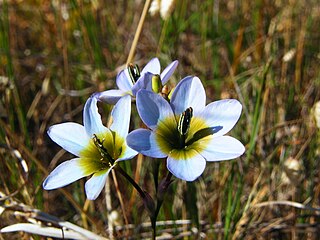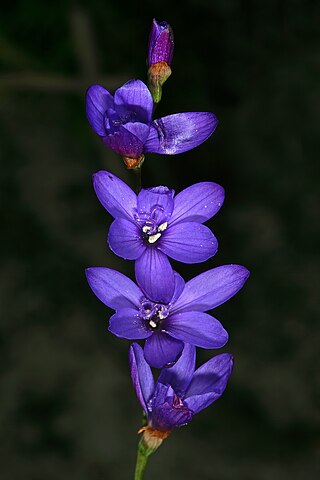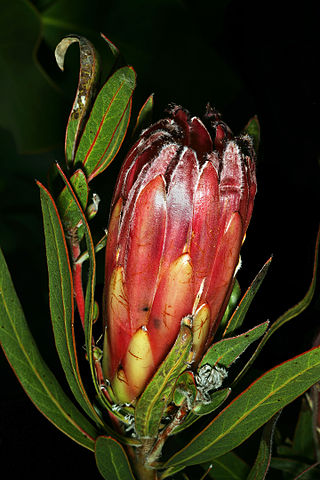
Disa is a genus of flowering plants in the family Orchidaceae. It comprises about 182 species. Most of the species are indigenous to tropical and southern Africa, with a few more in the Arabian Peninsula, Madagascar, and Réunion. Disa bracteata is naturalised in Western Australia, where the local name is "African weed-orchid."

Disa uniflora, the red disa or pride of Table Mountain, is a South African species of orchid in the family Orchidaceae. It is the type species of the genus Disa, and one of its best-known members. It is occasionally referred to by its old name Disa grandiflora.

Disa purpurascens is a species of orchid found in South Africa. It is also known as the early blue disa or the bloumoederkappie.

Serapias vomeracea, common name long-lipped serapias or plow-share serapias, is a species of orchid in the genus Serapias.

Leporella fimbriata, commonly known as hare orchid or fringed hare orchid, is the only species in the flowering plant genus Leporella in the orchid family, Orchidaceae and is endemic to the southern Australia mainland. It is related to orchids in the genus Caladenia but has an unusual labellum and does not have hairy leaves. Its pollination mechanism is also unusual.

Lyperanthus, commonly known as beak orchids, is a genus of flowering plants from the orchid family, Orchidaceae, that is endemic to Australia. There are two species, one in Western Australia and the other in four eastern Australian states, distinguished by their single long, narrow, leathery leaf and dull coloured flowers which have prominent short calli on their labellum. Both form loose colonies which reproduce asexually from their tubers, and sexually using their flowers.

Pyrorchis, commonly known as beak orchids, is a genus of flowering plants in the orchid family, Orchidaceae and is endemic to Australia. It contains two species which were previously included in the genus Lyperanthus, also known as beak orchids. Both species have fleshy, oval leaves and form colonies which flower profusely after bushfires.

Moraea aristata is a species of flowering plant in the family Iridaceae. It is referred to by the common names blue-eyed uintjie or Blouooguintjie in Afrikaans.It is endemic to the city of Cape Town and is considered to be critically endangered.

Baeometra is a genus in the family Colchicaceae containing a single species, Baeometra uniflora. It is native to South Africa, where it is commonly called beetle lily due to the dark markings on the tepals.

Gladiolus alatus is a species of geophyte from South Africa. Common names include painted ladies, king kalkoentjie and kipkippie. Kalkoentjie means "little turkey" in Afrikaans and refers to the shape of the flower, which resembles a turkey's wattle. It is popular as a garden plant and an important part of the cut flower industry in parts of the world on account of its large and showy orange flowers.

Ixia monadelpha, also known as the pied kalossie or bontkalossie, is an endangered species of geophyte found in wet sandy flats in the southwestern Cape of South Africa.

Geissorhiza aspera, also known as the blue satin flower or blou sysie, is a geophyte from South Africa.

Disa ferruginea also known as the cluster disa, is a species of orchid from South Africa.

Leucadendron salignum, also known as the common sunshine conebush, is an evergreen, dioecious shrub in the family Proteaceae. It produces several stems from the ground of up to 2 metres high. It survives the wildfires that occur every one or two decades in the fynbos, where it occurs, by regrowing from an underground rootstock. Pollinated by beetles, it flowers from April to November. The winged seeds remain in the woody cones until they are released after a fire, and are distributed by the wind. It is possibly the most common Proteaceae species in South Africa, and can be found in the Northern Cape, Western Cape and Eastern Cape provinces. Its current conservation status is Least Concern.
Caladenia rosea is a plant in the orchid family Orchidaceae and is endemic to relatively inaccessible, high lateritic plateaux in a high rainfall area in south-western Western Australia. It is a terrestrial orchid with a single hairy leaf and up to three pink flowers on a thin, sparsely-hairy stem. It is similar to Caladenia flava but is distinguished by the perianth being pink to dark pink with prominent red striping and spotting on the dorsal sepal and lateral petals. Caladenia rosea mimics Hypocalymma robustum (Myrtaceae) in terms of flowering time, colour and scent.

Protea pendula, also known as the nodding sugarbush or arid sugarbush, is a flowering plant of the genus Protea, in the family Proteaceae, which is only found growing in the wild in the Cape Region of South Africa. In the Afrikaans language it is known as knikkopsuikerbossie or ondersteboknopprotea.

Bartholina burmanniana, the spider orchid, is a species of deciduous, geophytic, flowering plant in the family Orchidaceae. It is one of two species within the Bartholina genus, the other being B. etheliae. The species’ common name refers to its spreading and deeply cut lip that is said to resemble a spider's legs. It is native to the Eastern and the Western Cape Provinces of South Africa, flowering from the end of August to the middle of October and peaking in September. This is one of the species sometimes referred to as "spider orchid".

Protea burchellii, also known as Burchell's sugarbush, is a flowering shrub in the genus Protea, which is endemic to the southwestern Cape Region of South Africa.

Cyphia bulbosa, also known by its common name Bulb Baroe, is a species of flowering plant from the genus Cyphia.
Pterostylis bracteata is a species of flowering plant in the orchid family Orchidaceae and is endemic to the northern Flinders Ranges in South Australia. It has a rosette of leaves at its base and 2 to 5 translucent white flowers with prominent maroon or lead-coloured markings with a green insect-like labellum with bristly hairs.


















